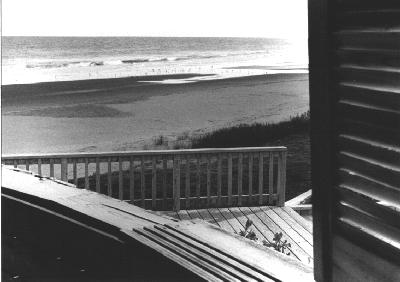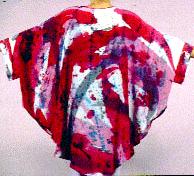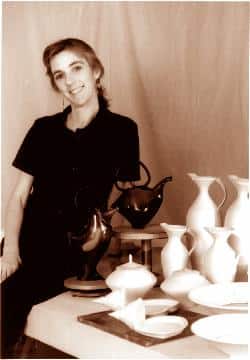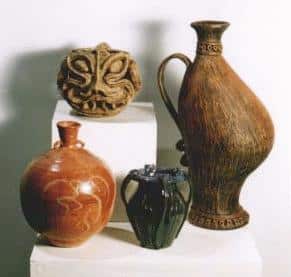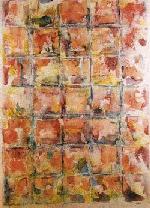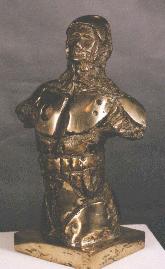Photography by Edward Shmunes
September 1-30, 1998
Smith University Center Gallery
Edward Shmunes has been photographing for only twelve years. During this period his work has received 67 awards from among 24 international, 135 national, and 63 regional juried art exhibitions. Thirty-five of these awards were from international and national shows.
“My approach is to try to capture pieces of things that retain the emotional essence of the whole. I lean toward colors that are somewhat removed from reality and will add dyes by hand to the imagery to augment color and add emotional content. I see my work as operating on two levels: the actual composition and as commentary on life as evoked through symbolism of the objects presented.”
Fabric Art and Jewelry by Carol C. Anderson
October 4-30, 1998
Fine Arts Center Gallery
Graduate of the Ontario College of art and George Brown College, Toronto, Canada, Carol Anderson taught for many years with the Toronto Board of Education, providing instruction in clay, copper, enamel, tie dye, fabric painting and jewelry making and was the owner and operator of “Children’s Art School.” She was recipient of many awards and grants, including travel scholarship from the Toronto craft council for a nine week study tour of Europe. Carol relocated to Columbia in 1986 and was jewelry instructor at the Columbia Museum of Art until 1990. In 1989 she received a purchase award from the Rock Hill Arts Council, first prize for jewelry from the SC State Fair Art Exhibit, and a Merit award at Mayfest Columbia, 1989. In 1992 she was invited to demonstrate her work at Arts Alive. Carol was also invited to exhibit her work at the Sumter Gallery of Art. She was artist-in-residence at the Opportunity School and Fairfield Central High School and also a volunteer for Cities-In-Schools at Atlas Road and Five Points Schools in Columbia. Through the SC Arts Commission’s approved artist’s roster, she has done over 150 one to nine week residencies in SC schools.
As a child growing up in the West Indies, constant exposure to the lush greenery and natural flora of the Caribbean lent itself very easily to emphasis on watercolor for Carol. Her commitment to art expression grew as she discovered the mystery of clay and the power and strength of sculpture. The inclusion of Kenyan batik dyed cowhorn beads in her jewelry is the most recent example of the influence of her visits to Kenya, where she plans to return and teach next year.
Carol’s sculpture gradually became miniature in size so that she eventually went back to college to study jewelry full-time.
Carol has come full circle in her art-expression, for now that she finds that her current painting on silk has progressed very naturally from her earlier watercolor experience.
Glyphs, Phosphenes, Symbols and Elements: Paintings and Woodcuts by Tom Ogburn
October 4-30, 1998
Smith University Center Gallery
Woodcut (Elemental Series) Statement:
The woodcut is a way for me to reacquaint myself with the organic. I have begun this series, in a group I call “Elementals,” to build a collective of images that are linked by the process of carving the woodcut block. Each image is derived from a block or multiple blocks used in the making of the image preceding it. Each image is therefore derivative of the one that came before, with the skeletal structure of each successive work printed from the remnant image of the work preceding the newer one.
I am working with a four inch square area, amassing a number of very interrelated pieces that are small abstractions based on the concept of the elemental. Each image has its origin in a simple visual translation of plant, animal, earth, fire, air, water, moons, stars and the cosmos.
The forty images used in this series are meant to be viewed as a whole, with each part playing a role in the overall collective presentation. The independent nature of the individual prints are combined, as are the elements in our world, to create a larger and more complex structural assemblage of shapes which work as a whole.
Painting Statement:
There is a feeling of distance and mystery when we view remnants of an ancient civilization. It is a forgotten mechanic, an existence which long ago passed into the realm of the outmoded. While art and culture of the stone age is but conjecture on our part, our own culture’s most recent history is also quickly disappearing. The memories that we cherish soon expire when passed on to a new generation that is busily creating more current, more vibrant memories of their own.
Ancient cultures have a strong bond and faith in the unknown, and their acceptance of the dream world as reality is widely documented. My recent works have developed from a look into dreams, history, and folklore of strangers, friends, family, and my own experiences. I try to visually explore multiple dimensions, and invoke the possibility that both distant and unrelated events or persons can occupy the same space at the same time.
As modern people, we have manipulated nearly every part of our world. This manipulation often conceals the past achievements which our forebears took pride in accomplishing and creating. Yet for every stone thrown into the water there is a ripple effect long after that stone has disappeared. For every sound there is a lingering echo. These reverberations of life, both distant and relatively near, still surround us. These are the subjects of my paintings.
Porcelain by Susan Filley
November 4-25, 1998
Fine Arts Center Gallery
Susan Filley received her Masters of Fine Arts in Ceramics from Louisiana State University. Her contemporary porcelain studio is situated along an inland marsh in Charleston, South Carolina. She exhibits her work internationally at shows and galleries and teaches at workshops, colleges, and craft schools.
ARTIST STATEMENT
I work with porcelain, a wonderfully rich clay with beautiful surface qualities. It is defined by it’s extreme durability and distinctive smooth white color. I love to decorate, and draw with bold black and white designs and colorful slips on many of my forms, using a unique style of calligraphic brushwork. I use my background in figurative drawing and botanical illustration in creating both surface imagery and sculptural components. I have developed my glazes pursuing the stunning depth and brilliance that is unique to high temperature porcelain.
Over this past year I have started a new series in my work. Through a shift in scale and with the development of several new glazes, I am creating a body of work called Promenade Jewels. Evolving from the Dancing Teapot series, these pieces are smaller and more intimate. The original concept of a Parade of Teapots’ came from working with the gesture the dancing teapot series. I continue to create a sense of elegance that is both distinctive and very personal. Adding stronger jewel like color, fanciful elements of design, and playful gestural movement, I feel that these petite teapots and precious little cups create an impression far greater than their actual dimensions.
The intrinsic beauty of porcelain works well with my affinity toward detail, and they are used together to create a sense of delight and intimacy in my work. I like a pot that tells its own story, that asks to be touched or tells me to treasure it, to step back to admire it or serve something special. The synthesis of idea through form, function, and technique is vital in all artwork, from a simple bowl to involved sculptures.
Paintings by James Cassara
November 4-25, 1998
Smith University Center Gallery
Artist’s Statement
In preparing for this exhibit I began thinking about the themes which have run through my most recent works. At the same time those concerns which occupy me as an artist, thinker, and person, began emerging. I soon came to realize how those things I am, and the work I create, are one and the same. It is this fascination with the creative process, with the very idea of making something from what others might see as a void, that has driven me since I was first able to articulate ideas and put crayon to paper.
Some of my earliest memories, and no doubt some of my happiest, are of my stretching out on the terrazzo floor of our south Florida home and copying images from comic books. Four color, badly printed, and indispensable in my tutorage, they opened for me a world of images, zooming across the page and the universe. My heroes were not just the characters who conquered evil, but those comic book artists, Jack Kirby and Steve Ditko principally, who showed me how heroes could. The interaction of words and pictures set me forth on a journey of discovery, one which has led me to my life as an artist and art educator.
My work is a reflection of that journey, and of everything that I am. Each painting presents new challenges, another problem to be solved. The canvas takes on a life of its own, with me not as driver but as befuddled passenger, never certain knowing where it might lead but confident and faithful in the process. It is my job to organize those thoughts and express them with brush or pen. It is the viewer’s task to bring their own sense of being into a private and uniquely individual interpretation.
Irreverent and Essential Illuminations: computer manipulated digital prints by Dr. Donna H. Goodman
Hyman Fine Arts Center Gallery
Local Clay: pottery and sculpture by Sasha Federer, Wanwadee Larsen, Ken Rose & Elijah Thomas
Smith University Center Gallery
January 11-29, 1999
Sasha Federer
Rumanian born Sasha Federer is a therapist at Carolinas Hospital System and a tireless potter. His work is marked by skill and the chameleon-like way in which he constantly varies technique and form. This show includes hand built raku pieces, terra cotta wall flowers, a shino glaze pot made of Lynche’s river clay, and a vase made of rough textured brick clay.
Wanwadee Larsen
Born in Thailand and trained at Francis Marion, Wanwadee Larsen sculpts figures that celebrate humanity. This show includes the figure of Daphne changing into a tree, faces of women that seem to tell stories, and two large hand built pots, one of which evokes a spinning dancer, the other a pregnant woman.
Larsen says: “My art is dedicated to bringing observers to an awareness of mankind’s inner nature. The individual pieces tend to be traditional in a sense, but also to bring out contemporary issues and states of mind. Everyday objects and ideas are portrayed in unusual combinations. Underlying all is the feeling that in a universe of mostly inanimate phenomena, people are absolutely phenomenal: humanity is the living, dynamic, animate center of the universe.
Ken Rose
Ken Rose of Hartsville sculpts faces that evoke world art, remembered glimpses from a lifetime of looking at the pages of National Geographic magazine. Vikings, African masks, stone temples, Celtic figures, and whimsical figures drawn from the intersection of popular culture and primal memory stare out from his work. Rose’s terra cotta and stoneware is often marked by the smokey colors of clay and kiln ash, looking as though it may have emerged from an archeological dig.
Of his work, Rose says: “I don’t consider myself an artist. I put ‘sculptor’ on my business cards because I don’t think people would understand if I put ‘plays in the mud.'”
Elijah Thomas
After retiring from Amtrak, Florentine Elijah Thomas studied ceramics at Francis Marion and took up a hobby that has become a calling. Thomas’ vases and cups are most often thrown on a wheel in a low fire clay and glazed in a wide variety of colors.
Many of his pieces echo traditional forms of southern pottery, and his “Confederate cups” and “Union cups” have been commissioned by Southern Living magazine. Thomas is a featured potter at the Red Barn Visual Arts Center at the Pee Dee Farmers Market and welcomes visitors to his studio. The Red Barn
All of the artists featured in this show have studios at the Red Barn Visual Arts Center at the Pee Dee Farmers Market on U.S. 52 north of Florence. The Red Barn is open to visitors on Fridays and Saturdays from 11:30 until 5:30.
Paintings by Jack Dowis
February 2-27, 1999
Smith University Center Gallery
Jack Dowis is a practicing architect who has had an avocational interest in drawing and painting for most of his adult life. He is one of Carolina Eight, a group of North and South Carolina artists organized for group exhibitions and the exchange of ideas. In addition to exhibiting in groups shows and one-artists shows, he is a regular contributor to competitive exhibitions and has won a number of awards. He is represented in numerous collections, including the South Carolina State Art Collection. He is a member of the Florence Artists Guild and the Pee Dee Artisans Guild, and a Member of Excellence and past president of the South Carolina Watercolor Society.
Although he has had brief periods of instruction in workshops and part-time classes under such notable artists-teachers as Gil Petroff, Lawrence Anthony, John Brady, Christopher Schink, Jeanne Dobie, Edward Betts, and Glen Bradshaw, Dowis is essentially “self-taught,” having developed his skills and understanding of art through study, practice, and experimentation. As a teacher, he shares this knowledge and experience through classes and workshops for both beginning students and accomplished artists.
Dowis has referred to himself as “an experimental painter” and many of the twenty-six pieces in this exhibit are the results of his constant exploration of rather unconventional media as well as different ways of working with the “conventional” ones. The exhibit shows remarkable versatility and includes pieces created in a variety of styles and subjects from misty wooded vistas to architectonic cityscapes.
For more than forty years, Dowis has been actively involved in the advancement of the arts in his community, region, and state. He was instrumental in the founding and organization of the Florence Area Arts Council and served a year as its president. He is a trustee of the Florence Museum and served from 1960 to 1970 and again from 1972 to 1975 as President of the Museum and Chairman of the Board of Trustee. When the South Carolina Arts Commission was organized in 1967, he was one of the original commissioners appointed by then-Governor John West; he served in that capacity for five years, including three years as Chairman of the Selection Committee for the State Art Collection. He is also a Member Emeritus and past president of the South Carolina Chapter, the American Institute of Architects.
Bronze Sculpture by Winston Wingo
February 2-27, 1999
Hyman Fine Arts Center Gallery
Winston Wingo’s sculptures evoke the tension between man and technique in the technological age, an age when institutions ranging from governments to factories have attempted to mold humans to fit the institutions’ needs in the name of efficiency but without consideration for the human needs of those within the systems created by and for technique. Wingo refers to his sculptures as ‘cyborgs,’ a mix of human and machine that is a metaphor for systems that dehumanize people.
Wingo has exhibited extensively in South Carolina’s museums and galleries. He has created public sculptures including the Martin Luther King, Jr. bust in Spartanburg, “The History of the Block” in Asheville, celebrating an area of African American owned businesses, and the “Stop the Violence” sculpture at Spartanburg Memorial Auditorium which incorporates dismantled guns received during a goods for guns exchange.
Wingo’s bronzes are cast using the lost wax process employing a ceramic shell procedure for making molds. He does his casting in Pietrasanta, Italy, where he studied with sculptor Robert Bertola at the Luigi Tommas Foundry, receiving a certificate from the Instituto Statuele D’ARTe’ in Lucca Italy. Prior to that, Wingo completed his MFA in painting and sculpture at Clemson and his BA in Art Education at Claflin College in Orangeburg.
Wingo is an art instructor at L. E. Gable Middle School in Spartanburg. He has also been an instructor at Hughes Middle School in Greenville, S.C. State University, Claflin College, Greenville Technical College, USC Spartanburg, and a sculptor in residence at the College of Charleston.
Irreverent and Essential Illuminations
computer manipulated digital prints by Dr. Donna H. Goodman
Hyman Fine Arts Center Gallery
February 2-27, 1999
Senior Show by Bradley Carter, Maggie Hobbs, Caroline Jessen and Scott McCrea
Smith University Center Gallery
March 2-26, 1999
Ceramics by Doug Gray
Hyman Fine Arts Center Gallery
March 2-26, 1999
Senior Show by Gena Kaltwang, Miriam Smith, Bradley Carter and John Clark
Smith University Center Gallery
March 30 – April 21, 1999
Senior Show by Bradley Carter, Carolina Jessen and Scott McCrea
Hyman Fine Arts Center Gallery
March 30 – April 21, 1999
Against the Grain: printmaking group show by Osmosis:
Eileen Blyth, Jeff Donovan, Michael Dickens, Christophet MatyJasik, Tom Ogburn and Laura Spong
Hyman Fine Arts Center Gallery
April 5 – May 6, 1999
Exhibits by FMU Drawing & Painting Students
Smith University Center Gallery
April 24 – May 8, 1999
Exhibits by FMU Ceramics and Three-Dimensional Design Students
Photographs by Retiring Galleries Curator Walter Wallace Sallenger
Hyman Fine Arts Center Gallery
April 24 – August 15, 1999
